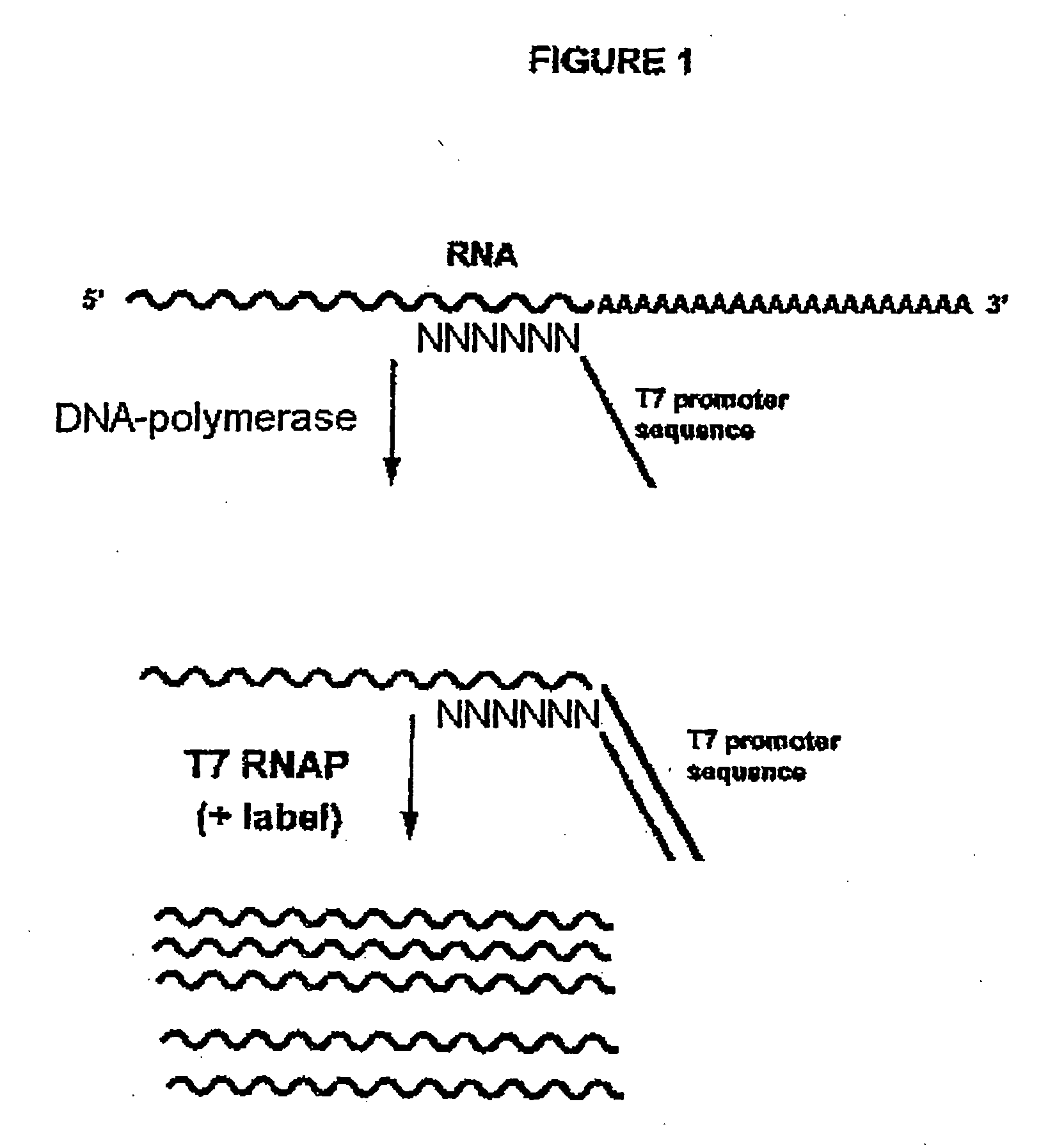Methods for generating rna copies
a technology of rna and copies, applied in the field of generating rna copies, can solve the problems of pcr, high false positive test percentage, limited nucleic acid hybridisation assay sensitivity, etc., and achieve the effect of not directly applicable to rna
- Summary
- Abstract
- Description
- Claims
- Application Information
AI Technical Summary
Problems solved by technology
Method used
Image
Examples
example 1
Random Primed-tyras Reaction 1
[0101] 100 ng of in vitro transcribed RNA (pGEMExpress Positive Control Template transcribed according to protocol TM0126 of Promega) is used as a template in the random primed-tyras reaction 1. This reaction contains 3.6 μl water with 100 ng of this template, 4 μl 5×NN buffer (Tris-HCl 200 mM, pH 8.5; MgCl2 60 mM; KCl 350 mM; DTT 25 mM; dNTP's 5 mM of each; rATP, RCTP and GTP, 2 mM of each), 1.8 μl 100 mM rUTP and 1.6 μl of 10 mM Flu-UTP, 4 μl primer mix [37.5 μl 100% DMSO, 5 μl of a 100 μM oligonucleotide with the sequence:
AATTCTAATACGACTCACTATAGGGAGAGAAGGATA(SEQ ID NO: 1)CCACTAGCTAGCGNNNNNN
(of which the last six nucleotides represent a random hexamer -N stands for an equimolar mixture of A,C,G and T bases- of which the last nucleotide is a 2′-3′ dideoxynucleotide and the final phosphate bond has been exchanged with a phosphorothioate bond) and 7.5 μl water for a total volume of 50 μl ].
[0102] This reaction is incubated at 65° C. for 5 minutes a...
example 2
Random Primed-tyras Reaction 2
[0106] 100 ng in vitro transcribed RNA (Luciferase SP6 Control DNA, restricted with Sacl and transcribed according to protocol TM0126 of Promega) was used as a template in the random primed-tyras reaction 2. This reaction contained (end concentration is indicated) Tris-HCl 40 mM, pH 8.5, MgCl2 16 mM, KCl 30 mM, DTT 50 mM, sorbitol 375 mM, BSA 2.0 mg, dNTP's 5 mM each, rATP, RCTP, rGTP, 2 mM each, rUTP 1.8 mM, Flu-UTP 0.2 mM and an oligonucleotide with sequence:
AATTCTAATACGACTCACTATAGGGAGAGANNNNNN(SEQ IDNO: 2);
of which the last six nucleotides represent a random hexamer, -N stands for an equimolar mixture of A, C, G and T bases- of which the last nucleotide is a 2′-3′ dideoxynucleotide) 10 μM in an end volume of 9 μl.
[0107] This reaction was incubated for 15 minutes at 30° C., after which the temperature was increased to 37° C. Immediately thereafter, 6 units AMV-reverse transcriptase were added to the reaction and the mixture was gently mixed by t...
PUM
| Property | Measurement | Unit |
|---|---|---|
| total volume | aaaaa | aaaaa |
| total volume | aaaaa | aaaaa |
| end volume | aaaaa | aaaaa |
Abstract
Description
Claims
Application Information
 Login to View More
Login to View More - R&D
- Intellectual Property
- Life Sciences
- Materials
- Tech Scout
- Unparalleled Data Quality
- Higher Quality Content
- 60% Fewer Hallucinations
Browse by: Latest US Patents, China's latest patents, Technical Efficacy Thesaurus, Application Domain, Technology Topic, Popular Technical Reports.
© 2025 PatSnap. All rights reserved.Legal|Privacy policy|Modern Slavery Act Transparency Statement|Sitemap|About US| Contact US: help@patsnap.com

